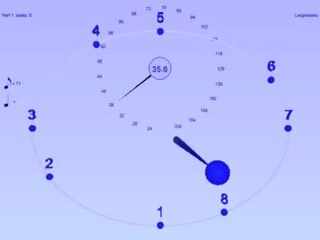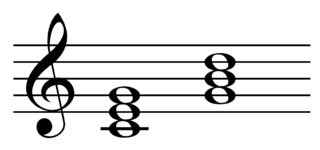
Dance is a performing art form consisting of sequences of movement, either improvised or purposefully selected. This movement has aesthetic and often symbolic value. Dance can be categorized and described by its choreography, by its repertoire of movements, or by its historical period or place of origin.

In music performances, rhythm guitar is a technique and role that performs a combination of two functions: to provide all or part of the rhythmic pulse in conjunction with other instruments from the rhythm section ; and to provide all or part of the harmony, i.e. the chords from a song's chord progression, where a chord is a group of notes played together. Therefore, the basic technique of rhythm guitar is to hold down a series of chords with the fretting hand while strumming or fingerpicking rhythmically with the other hand. More developed rhythm techniques include arpeggios, damping, riffs, chord solos, and complex strums.
In musical terminology, tempo is the speed or pace of a given piece. In classical music, tempo is typically indicated with an instruction at the start of a piece and is usually measured in beats per minute. In modern classical compositions, a "metronome mark" in beats per minute may supplement or replace the normal tempo marking, while in modern genres like electronic dance music, tempo will typically simply be stated in bpm.

A metronome, from ancient Greek μέτρον and νέμω, is a device that produces an audible click or other sound at a regular interval that can be set by the user, typically in beats per minute (BPM). Metronomes may include synchronized visual motion. Musicians use the device to practise playing to a regular pulse.

Alizarin is an organic compound with formula C
14H
8O
4 that has been used throughout history as a prominent red dye, principally for dyeing textile fabrics. Historically it was derived from the roots of plants of the madder genus. In 1869, it became the first natural dye to be produced synthetically.

The Carnival of the Animals is a humorous musical suite of fourteen movements by the French composer Camille Saint-Saëns. The work, about 25 minutes in duration, was written for private performance by two pianos and chamber ensemble; Saint-Saëns prohibited public performance of the work during his lifetime, feeling that its frivolity would damage his standing as a serious composer. The suite was published in 1922, the year after his death. A public performance in the same year was greeted with enthusiasm, and the work has remained among his most popular. In addition to the original version for chamber ensemble, the suite is frequently performed with a full orchestral complement of strings.

Boléro is a one-movement orchestral piece by the French composer Maurice Ravel (1875–1937). Originally composed as a ballet commissioned by Russian actress and dancer Ida Rubinstein, the piece, which premiered in 1928, is Ravel's most famous musical composition.
The siciliana[sitʃiˈljaːna] or siciliano[sitʃiˈljaːno] is a musical style or genre often included as a movement within larger pieces of music starting in the Baroque period. It is in a slow 6
8 or 12
8 time with lilting rhythms, making it somewhat resemble a slow jig or tarantella, and is usually in a minor key. It was used for arias in Baroque operas, and often appears as a movement in instrumental works. Loosely associated with Sicily, the siciliana evokes a pastoral mood, and is often characterized by dotted rhythms that can distinguish it within the broader musical genre of the pastorale.

A rhythm section is a group of musicians within a music ensemble or band that provides the underlying rhythm, harmony and pulse of the accompaniment, providing a rhythmic and harmonic reference and "beat" for the rest of the band. The rhythm section is often contrasted with the roles of other musicians in the band, such as the lead guitarist or lead vocals whose primary job is to carry the melody.
Lowell Liebermann is an American composer, pianist and conductor.

In music, notes inégales refers to a performance practice, mainly from the Baroque and Classical music eras, in which some notes with equal written time values are performed with unequal durations, usually as alternating long and short. The practice was especially prevalent in France in the 17th and 18th centuries, with appearances in other European countries at the same time; and it reappeared as the standard performance practice in the 20th century in jazz.

Pyotr Ilyich Tchaikovsky's Symphony No. 3 in D major, Op. 29, was written in 1875. He began it at Vladimir Shilovsky's estate at Ussovo on 5 June and finished on 1 August at Verbovka. Dedicated to Shilovsky, the work is unique in Tchaikovsky's symphonic output in two ways: it is the only one of his seven symphonies in a major key ; and it is the only one to contain five movements.
Caucasian Sketches is a pair of orchestral suites written in 1894 and 1896 by the Russian composer Mikhail Ippolitov-Ivanov. The Caucasian Sketches is the most often performed of his compositions and can be heard frequently on classical radio stations. The final movement of the Caucasian Sketches, Suite No. 1, entitled Procession of the Sardar, is often heard by itself, and is a favorite of "Pops" concerts.
A gargoyle is a grotesque statue.
The First Suite in E♭ for Military Band, Op. 28, No. 1, by the British composer Gustav Holst is considered one of the cornerstone masterworks in the concert band repertoire. Officially premiered in 1920 at the Royal Military School of Music, the manuscript was originally completed in 1909. Along with the subsequent Second Suite in F for Military Band, written in 1911 and premiered in 1922, the First Suite convinced many other prominent composers that serious music could be written specifically for band.

In music, gesture is any movement, either physical (bodily) or mental (imaginary). As such "gesture" includes both categories of movements required to produce sound and categories of perceptual moves associated with those gestures. The concept of musical gestures has received much attention in various musicological disciplines in recent years.
Alexander Borodin's Scherzo in A-flat major is a lively piece written in 1885, while Borodin was in Belgium for an early performance of his then incomplete opera Prince Igor. It was originally written for solo piano but in 1889 Alexander Glazunov orchestrated it, along with the Petite Suite. Borodin dedicated the piece to Théodore Jadoul, who made a four-hand piano arrangement of it.

The Concerti Grossi, Op. 6, or Twelve Grand Concertos, HWV 319–330, are 12 concerti grossi by George Frideric Handel for a concertino trio of two violins and violoncello and a ripieno four-part string orchestra with harpsichord continuo. First published by subscription in London by John Walsh in 1739, in the second edition of 1741 they became Handel's Opus 6. Taking the older concerto da chiesa and concerto da camera of Arcangelo Corelli as models, rather than the later three-movement Venetian concerto of Antonio Vivaldi favoured by Johann Sebastian Bach, they were written to be played during performances of Handel's oratorios and odes. Despite the conventional model, Handel incorporated in the movements the full range of his compositional styles, including trio sonatas, operatic arias, French overtures, Italian sinfonias, airs, fugues, themes and variations and a variety of dances. The concertos were largely composed of new material: they are amongst the finest examples in the genre of baroque concerto grosso.
The Musette, or rather chaconne, in this Concerto, was always in favour with the composer himself, as well as the public; for I well remember that HANDEL frequently introduced it between the parts of his Oratorios, both before and after publication. Indeed no instrumental composition that I have ever heard during the long favour of this, seemed to me more grateful and pleasing, particularly, in subject.
Eight Improvisations on Hungarian Peasant Songs, Op. 20, Sz. 74, BB 83, also known as Improvisations on Hungarian Peasant Songs or simply as Improvisations, is a composition for solo piano by Hungarian composer Béla Bartók. It was finished in 1920.
Beni Mora is a three-movement suite of music in E minor for large orchestra, by Gustav Holst. The first performance was at the Queen's Hall, London, on 1 May 1912, conducted by the composer. The work was inspired by music Holst heard in Algeria during a holiday in 1908. The constant repetition of one theme from Arabic folk music in the last movement has been described as a precursor of modern minimalism. The piece also includes dance rhythms and wistful, slow sections, and makes strong use of woodwinds and percussion. Beni Mora has been recorded several times by British orchestras, most recently in 2011.










